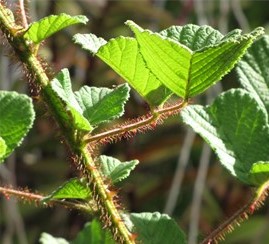THE TARGETS: YELLOW HIMALAYAN RASPBERRY (RUBUS ELLIPTICUS VAR. OBCORDATUS) & MYSORE RASPBERRY (RUBUS NIVEUS)
Description:
Both yellow Himalayan raspberry (Rubus ellipticus var. obcordatus) and Mysore raspberry (Rubus niveus) are Hawaiʻi state listed noxious weeds that form impenetrable thickets of stems covered in sharp thorns. These sprawling brambles threaten native forests and displace native plant species, including the native Hawaiian raspberry, ‘akala (Rubus hawaiiensis).
Mysore raspberry tends to occupy disturbed habitat such as roadside ditches, pastures, and urban areas. Yellow Himalayan raspberry also invades disturbed areas, including those created by pigs, and is considered one of the world’s 100 worst weeds.
Report this species if seen on Maui, Lanaʻi, Molokaʻi, or Kauaʻi
Distribution:
Mysore raspberry is known from populations on Kauaʻi, Maui and Hawaiʻi islands. Yellow Himalayan raspberry is only present in large numbers on Hawaiʻi island. Both species are native to the Himalayan region across parts of India, China, and southeast Asia.

A variety of natural enemies are still being considered for yellow Himalayan raspberry and Mysore raspberry control. Photo Credit: CABI
THE CANDIDATE(S):
- Early field surveys in India and China have identified a wide suite of organisms that live with and control the two raspberry species in their native range, including species of moths, beetles, and fungal pathogens among others.
- Field research, observations, and literature reviews have identified roughly 11 species of insects and 5 fungal pathogens as having potential as host specific biocontrols.
TIMELINE OF PROJECT PROGRESS:
- Preliminary host specificity testing is currently underway in the UK for one of the fungal pathogens.
- Permits to allow transfer to the UK for four of the prioritized insect species have been previously secured, and host specificity testing is planned once the agents can be recollected for export.
- If initial host testing of one or multiple of these species is promising, more in-depth testing and research into the biology of the natural enemy(s) will be need to be conducted before a draft environmental assessment (DEA) can be created.
FURTHER INFORMATION:
CABI website: Finding a Control for Himalayan Raspberry https://www.cabi.org/projects/finding-a-biocontrol-for-himalayan-raspberry


